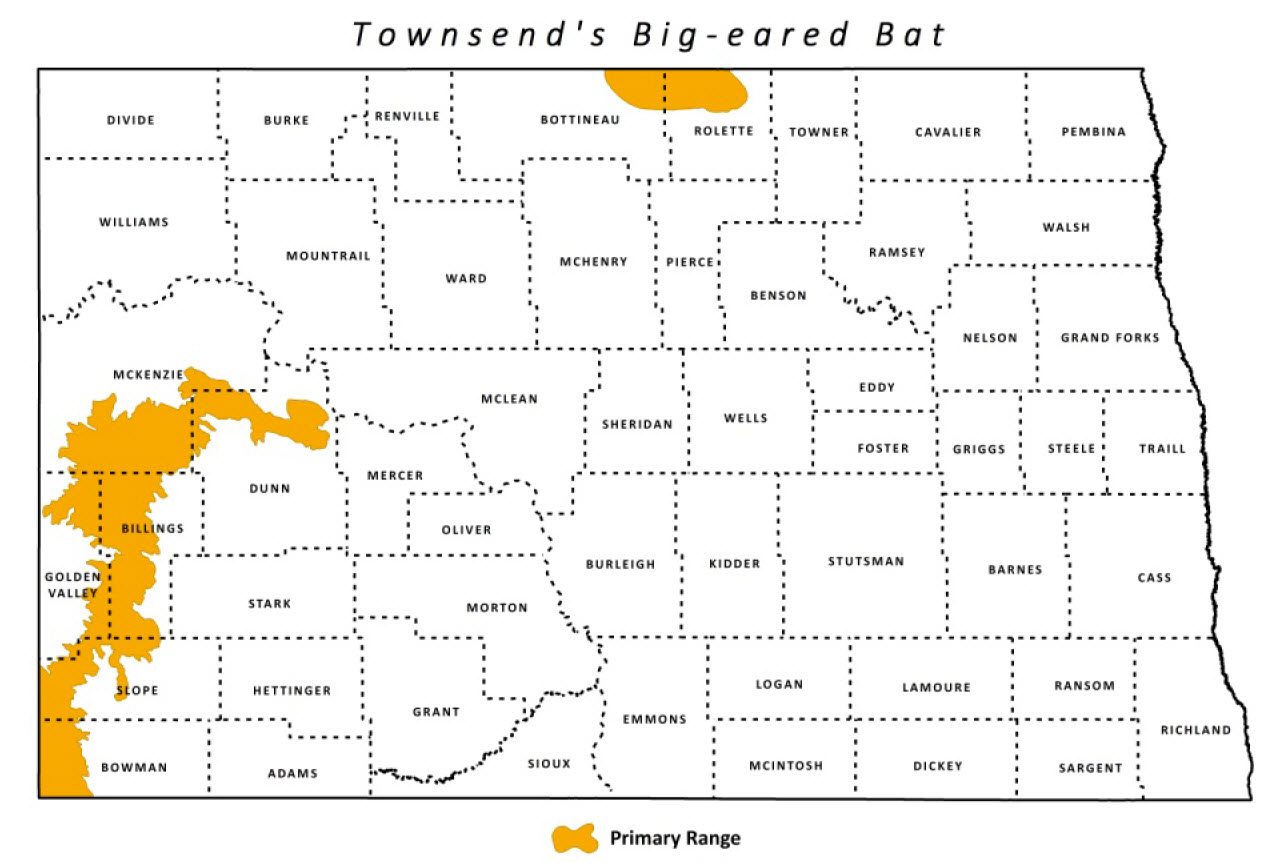
Townsend's Big-eared Bat
| Scientific Name | Corynorhinus townsendii |
|---|---|
| General Description | Distinguishable from other North Dakota bats by its oversized ears. The large fleshy ears are half the length of the body and connected to one another just about the eyes. Fur color ranges from brown to a dark gray. |
| Status | Seasonal as no hibernacula have been identified for this species in the state. |
| Abundance | Rare. |
| Primary Habitat | Can be found in a number of types of habitat in the summer months but most commonly around forest and riparian areas. Winter hibernacula is found in caves and mines with cool stable temperatures. This habitat has not been identified in North Dakota to date for this species. |
| Federal Status | No federal status. |
| Reason for Designation | Newly documented in the state. Listed as a state species of concern throughout the western United States. |
Locations and Conditions of Key Habitat
Preferred Habitat
Habitat generalist, but mostly commonly associated with forest and riparian areas in the summer months. Winter hibernacula include caves and mines throughout its range. A hibernacula has not been documented to date in North Dakota.
Key Areas and Conditions for Townsend's Big-eared Bat in North Dakota
In North Dakota Townsend’s Big-eared Bats are found within the badlands of the Little Missouri River. Also recently they have been documented in the Turtle Mountains region of the state.
Problems Which May Affect this Species
Habitat
This and other bat species in the state rely on caves and crevices for hibernacula and maternal grounds. These sites are susceptible to human and other types of disturbance. Frequent disturbance may cause females to drop young in the rearing process or abandon the area. Loss and disturbance of roost habitat is a primary threat.
Other Natural or Manmade Factors
Townsend’s Big-eared Bat and other bats in North Dakota are insectivores. Pesticides used in the vicinity of feeding grounds would affect bat populations by killing prey. Also, bats are known to store pesticides within fat reserves. Loss of water sources for drinking is also a potential threat. When natural water sources are dry, bats may resort to drinking from stock tanks. These can be potential bat traps. Wind turbines have been identified as a source of mortality to bats and several turbine “farms” are under construction in parts of North Dakota. Indiscriminate killing due to a negative public perception has been identified as a possible threat to this species. Loss of genetic diversity due to non-connectivity of populations.
Research and Survey Efforts
Current Research or Surveys
- Identification of hibernacula in western North Dakota as well as their susceptibility to White-nose Syndrome is being conducted by North Dakota State University.
- North Dakota State University is currently developing a North Dakota Bat Management Plan.
Previous Research or Surveys
- A survey of bat species in the state was conducted by North Dakota State University.
- A number of agencies have surveyed for small mammals in the southwestern part of the state including, REAP, Theodore Roosevelt National Park, the U.S. Forest Service, and U.S. Bureau of Land Management.
Additional Research or Surveys Needed
- Research to assess primary threats to this species.
- Life History requirements for this species specific to North Dakota should be investigated.
- Document the effects of energy development on western bat species.
Management Recommendations
- Protection and restoration of riparian habitat.
- Manage riparian habitats to maintain snags, connecting corridors, and edges.
- Maintain and improve seeps, ponds, and other wet areas as water sources.
- Education on the benefits and misconceptions about bats.
- Determine and protect nursery and hibernation sites.
- Provide roosting sites in areas where natural sites have been destroyed or disturbed.
- Reduce use of pesticides near waterways where bats forage.
Monitoring Plans
A monitoring protocol will be addressed in the North Dakota Bat Management Plan currently under development.
2005-2015 Progress
Townsend’s Big-eared Bat was added to the Species of Conservation Priority list during the revision of the Wildlife Action Plan in 2015. It is a state species of concern in many western states. SWG T2- 5-R Distribution and Habitat Use of the Bats of North Dakota documented Townsend’s Big-eared Bats including a potential range expansion.

Note: A listing of works consulted when compiling the information on this page may be found in the 2015 State Wildlife Action Plan.
